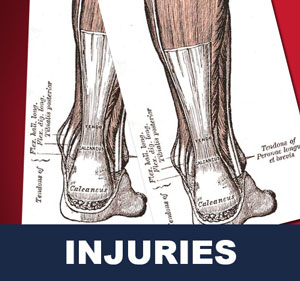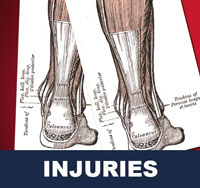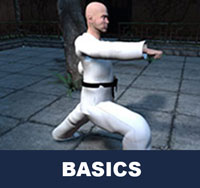Taekwondo 태권도Taekwondo Preschool
Promotion from one geup to the next can proceed rapidly in some schools, since schools often allow geup promotions every two, three, or four months. Students of geup rank learn the most basic techniques first, and then move on to more advanced techniques as they approach first dan. Many of the older and more traditional schools often take longer to allow students to test for higher ranks than newer, more contemporary schools, as they may not have the required testing intervals. View Taekwondo belt levels »

About Sprain
Sports injuries are injuries that occur in athletic activities. They can result from acute trauma, or from overuse of a particular body part. Please see a certified specialist or doctor for sports injuries. Proper guidance and instructions are needed from a certified Master Instructor ( 사범님 sabeomnim ) to ensure safe training.
A sprain is damage to one or more ligaments in a joint, often caused by trauma or the joint being taken beyond its functional range of motion. The severity of sprain ranges from a minor injury which resolves in a few days to a major rupture of one or more ligaments requiring surgical fixation and a period of immobilisation. Sprains can occur in any joint but are most common in the ankle and wrist.

Symptoms
- Pain
- Swelling
- Bruising
- Decreased ability to move the limb
- If a ligament ruptures, one may hear a popping sound
- Difficulty using the affected extremity
Classification
- First degree sprain - the fibres of the ligament are stretched but intact.
- Second degree sprain - is a tear of part of a ligament, from a third to almost all its fibers.
- Third degree sprain - is a complete rupture of the ligament, sometimes avulsing a piece of bone.
Diagnosis
A diagnosis of a sprain can often be made with a good degree of certainty by physical examination based on the clinical presentation and method of injury. In some cases, X-rays are obtained to ensure that there is no fracture. In some cases, particularly if the injury is prolonged or does not appear to be resolving as expected,magnetic resonance imaging (MRI) is performed to look at surrounding soft tissues and the ligament.
Causes
Sprains typically occur when the joint is taken beyond its functional range of motion.
Joints Involved
Although any joint can experience a sprain, some of the more common include:
- The ankle. It is the most common, and has been said that sprains such as serious ankle sprains are more painful and take longer to heal than actually breaking the bones in that area.
- The knee. Perhaps one of the more talked about sprains is that to the anterior cruciate ligament (ACL) of the knee. This is a disabling sprain common to athletes, especially in some styles of martial arts.
- The fingers.
- The wrist.
- The toes.
Risk Factors
There are certain factors which increase risk of sprains. Fatigue of muscles generally leads to sprains. When one suddenly starts to exercise after a sedentary lifestyle, sprains are quite common. While scientific studies are lacking, it is often thought that not warming-up is a common cause of sprains in athletes. Warming-up is thought to loosen the joint, increases blood flow and makes the joint more flexible.
Treatment
The first modality for a sprain can be remembered using the acronym RICE. The treatment of sprains depends on the extent of injury and the joint involved. Medications like non-steroidal anti-inflammatory drugs can relieve pain. Weight bearing should be gradual and advanced as tolerated.
- Rest: The sprain should be rested. No additional force should be applied on site of the sprain. In case of, for example, a sprained ankle, walking should be kept to a minimum.
- Ice: Ice should be applied immediately to the sprain to reduce swelling and pain. It can be applied for 10–15 minutes at a time (longer application of ice may cause damage instead of healing), 3-4 times a day. Ice can be combined with a wrapping to minimize swelling and provide support.
- Compression: Dressings, bandages, or ace-wraps should be used to immobilize the sprain and provide support. When wrapping the injury, more pressure should be applied at the far end of the injury and decrease in the direction of the heart; the reason for this is that it more easily causes unnecessary fluid to be flushed back up the blood stream in order to be recycled. Compression should not cut off the circulation of the limb.
- Elevation: Keeping the sprained joint elevated (in relation to the rest of the body) will also help minimize swelling.
Ice and compression (cold compression therapy) will not completely stop swelling and pain, but will help to minimize them as the sprain begins to heal itself. Careful management of swelling is critical to the healing process as additional fluid may pool in the sprained area.
The joint should be exercised again fairly soon, in milder cases from 1 to 3 days after injury. Special exercises are sometimes needed in order to regain strength and help reduce the risk of ongoing problems. The joint may need to be supported by taping or bracing, helping protect it from re-injury.

Related Articles
Sports injuries are injuries that occur in athletic activities such as in taekwondo. They can result from acute trauma, or from overuse of a particular body part. Collisions with the ground, objects, and other practitioners are common, and unexpected dynamic forces on limbs and joints can cause injury. View Sport Injuries »
- Achilles Tendon - the Achilles tendon is the most commonly injured tendon. Rupture can occur while performing actions requiring explosive acceleration, such as pushing off or jumping.
- Bone Fracture - a bone fracture is a medical condition in which there is a break in the continuity of the bone. A bone fracture can be the result of high force impact or stress, or a minimal trauma injury as a result of certain medical conditions that weaken the bones, such as osteoporosis, bone cancer, or osteogenesis imperfecta.
- Pulled Hamstring - defined as an excessive stretch or tear of muscle fibers and related tissues. Hamstring injuries are common in athletes participating in many sports and are very difficult to treat and rehabilitate.
- Sprain - damage to one or more ligaments in a joint, often caused by trauma or the joint being taken beyond its functional range of motion. The severity of sprain ranges from a minor injury which resolves in a few days to a major rupture of one or more ligaments requiring surgical fixation and a period of immobilisation.
- Sprained Ankle - also known as an ankle sprain, twisted ankle, rolled ankle, floppy ankle, ankle injury or ankle ligament injury, is a common medical condition where one or more of the ligaments of the ankle is torn or partially torn.
- Strain - an injury to a muscle in which the muscle fibers tear as a result of overstretching. A strain is also colloquially known as a pulled muscle. The equivalent injury to a ligament is a sprain.

Taekwondo Basics
Here is where you can learn more about Taekwondo 태권도. Knowing the fundamental basics is very important for your learning path as you build your skills and knowledge. There are certain rules that need to be followed to show respect to the master ( 사범님 sabeomnim ), the instructors ( 교사님 gyosannim ), other practitioners and to the martial arts. They vary between schools but many have similar rules and guidelines. For more information View Taekwondo Basics »
Please see a certified specialist or doctor for sports injuries. The article provided on this page is information that is widely available on Wikipedia article "Sprain". Risk of injury can be reduced by completing an effective warm up consisting of a heart raiser to get your pulse up, followed by sport specific dynamic stretches (stretches whilst moving). Please follow the guidance of a certified Master Instructor or trainer when doing sports related activities.
RESOURCES
This article uses material from the Wikipedia article "Sprain", which is released under the Creative Commons Attribution-Share-Alike License 3.0.





























